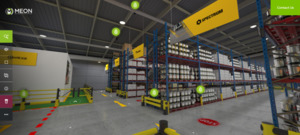

|
Edward Lowton
Editor |


|
| Home> | Industry update | >Company news | >Heavy machinery, light work |
Heavy machinery, light work
23 May 2025
Virtual 3D showrooms are changing the landscape for industrial process equipment manufacturers and buyers alike, explains Mark Worger

IN AN increasingly competitive industrial market, businesses face the daunting challenge of effectively showcasing products that are too large, too complex, or too bespoke to present through traditional marketing methods. Historically, industrial manufacturers have relied on physical demonstrations or printed documentation to communicate product specifications and benefits. However, these traditional methods, like paper brochures, static PDFs, or even professionally produced videos, often fall drastically short when trying to capture the sheer scale, complexity, or customisation potential of industrial machinery and equipment.
The rise of virtual showrooms and interactive 3D environments is transforming this significant marketing obstacle into a powerful, competitive advantage for the brands that embrace the technology. By creating photorealistic 3D digital twins of machinery and equipment, businesses can now offer an immersive experience, enabling customers to explore, interact with, and visualise products in hyper-realistic virtual settings. This shift from static to dynamic and interactive marketing profoundly enhances customer engagement and significantly streamlines the sales process.
The benefits of virtual showrooms
One of the core advantages of virtual showrooms lies in their unparalleled ability to simplify complex product presentations. Technical complexity is a fundamental characteristic of industrial manufacturing, making it inherently challenging for customers to fully grasp the nuances of machinery through conventional materials. In contrast, virtual 3D environments allow prospective buyers to interact directly with the products, explore components externally and internally, grasp the operational mechanics and explore customisation.
Neil Potter, head of marketing at Warehouse Safety Solutions, and an early adopter of the MARTECH3D platform, offered his approach. "The idea was to create a virtual experience centre for our customers to enter, and be fully immersed in to the environment of everything that we offer from products through to solutions." Expanding from an initial showroom to then include a warehouse, external expo areas, and a training academy. "This solution has helped us enormously to highlight all of our information in a very clear and simple way," he added.
Instant customisation
Interactive exploration significantly enhances comprehension in any sector, and in large, complex machinery, it helps build buyer confidence through direct, hands-on interaction. This is particularly true of bespoke customer configurations specific to an industry or process. Such immediate feedback dramatically accelerates decision-making, shortens sales cycles and reduces customer and vendor costs.
For sensitive sectors, virtual presentations can also circumvent security and regulatory concerns commonly associated with sensitive or restricted operational environments such as defence, biotech and pharma. The ability to virtually adapt and configure prospective machinery in real time to meet these specific and/or NDA requirements reduces the back-and-forth, minimises the time between meetings and ensures tighter IP security.
In open or prospecting environments, such as trade shows, websites and digital marketing, the virtual showroom is sure to start the conversation. Being able to demonstrate complex machinery, showroomed in a curated virtual environment in real-time, perhaps even without sales assistance, offers a similar uplift in engagement to that of video over a static presentation - up to 1200%. Virtual showrooms also provide a greater sense of realism and authenticity, leading to improved trust metrics of up to 75% higher than traditional B2B presentations and reduced decision time for significant B2B sales.
Given that over 70% of industrial buyers watch product videos during their research phase, and 90% of them say video is instrumental in their purchase decisions - how much more would a virtual showroom push that dial?
Expansions
Cloud-based virtual showroom systems with real-time access offer a unique selling proposition, but their greatest asset (particularly if your competitor is using a similar system) is their flexibility. From product updates to complete showroom makeover is relatively straightforward, enabling ‘nice to have’ touches such as branding virtual products or areas of the showroom for specific customer presentations. This can be extended after the sale to staff training sessions and onboarding.
Adding Augmented Reality (AR) integration within virtual showrooms further expands their potential. AR empowers potential customers to seamlessly blend digital product models with real-world operational environments. An engineer or factory manager can virtually position a new piece of equipment within their facility using only their smartphone or tablet. This real-world visualisation capability can reduce uncertainty regarding space constraints, fit, and operational compatibility far beyond the capabilities of CAD drawings.
An interactive and engaging system
Another company that has successfully implemented many of these functions into its B2B industrial sales process is Powder Systems Limited (PSL). PSL used MARTECH3D to create a comprehensive 3D Virtual Showroom for its full suite of products, complete with a 3D AR Product Viewer. Phase 1 launched in July 2024 at the ACHEEMA pharmaceutical manufacturing event, and late last year, the company further expanded the system to deliver virtual sales presentations for the business development team.
Sylvain Querol, head of business development at PSL, commented, "Our products, particularly for the pharmaceutical industry, can be huge, and we needed a more interactive and engaging system than a simple brochure. Full 3D environments with our product ranges and subcategories were the core of the design. We also created some virtual clean room environments where we can discover the client’s needs and adapt solutions we could offer to them. We also added the QR code AR modelling to drive further engagement."
"We have seen exactly what we wanted across the platform: people interacting with products in the environment, often on their own with no PSL staff involved, making their own journey and finding the information they are after. It’s been a massive help for our business development team, and we are rolling the systems out onto our website and planning to use it as a training and learning tool for our agents and distributor network worldwide."
Versatility in addition to ROI
The versatility of virtual showrooms also extends their applicability across multiple aspects of a manufacturer’s marketing strategy. At trade shows, interactive touch screens can showcase digital twins of equipment, enabling visitors to engage deeply without requiring expensive physical samples.
AIRSYS manufacture innovative, high-efficiency precision control thermal solutions for critical environments - components that are historically difficult to show. Matthew Thompson, MD Europe, explains "Working with MARTECH3D has allowed us to engage with more customers. Potential customers get a good idea of what we offer without us having to bring very big pieces of equipment to the trade show. Customers that would sometimes walk past the stand are intrigued. They see the screen, they want to engage with the screen, and they are then starting to learn about the product. They start to ask more questions and it builds the initial relationship."
Online, virtual environments embedded within company websites provide global accessibility to highly detailed product exploration, democratising the sales process and effortlessly reaching international audiences.
Boosting your marketing strategy
This has an invaluable impact on the ROI of your marketing strategy, particularly if factoring in the cost of traditional product logistics and multiple face-to-face meetings for real product demonstrations. Historically, transporting large-scale machinery to trade shows or customer facilities incurred enormous logistical expenses and potential risks associated with product damage during transportation.
Madelyn Haycock, marketing manager at AIRSYS adds: "The virtual showroom has been really important for us because our units are huge - one of them weighs over 900 kilos - so for a standard client meeting we can’t just take that around with us. We need something in our pocket so we can showcase all of our products in one go."
In contrast, once developed, virtual environments can be reused indefinitely and updated at minimal incremental cost. Cloud-based virtual environments with continuously updated core software ensure these systems will remain at the cutting edge of the virtual environment and AR technology without putting an enormous, centralised strain on your IT systems.
Industrial process
Leading adopters within the industrial process sector are already reporting tangible benefits from implementing interactive 3D marketing tools. Metrics consistently indicate shorter sales cycles, accelerated decision-making processes, and significantly higher conversion rates. Early users of this technology often experience double-digit growth in conversions, reinforcing the substantial commercial advantages of virtual marketing methods.
Ultimately, adopting virtual showroom technology is more than a simple upgrade; it represents a transformative strategy with profound implications for the entire industrial manufacturing sector. From overcoming the historical limitations associated with showcasing complex industrial products to significantly enhancing product understanding, customer confidence, and fast-tracking buying decisions, moving decisively into virtual showroom technology represents a significant strategic advantage.
Mark Worger is CEO at MARTECH3D
For more information:
Tel: 020 3146 6823
- How welders deal with magnetism in the component
- Starrag to present full line solutions at MENE
- Bale shortages hamper plastics recycling
- Cornwall manufacturer benefitting from Coronavirus struck supply chain
- Splitting Tracks
- Functional safety services at the national synchrotron
- INEOS paves way for shale gas development
- Brexit uncertainty continues to take toll on manufacturers
- MAINTAINING MOMENTUM
- Robust drive technology for extreme industrial environments




















